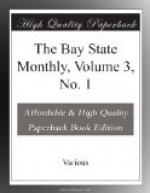While it is a fact, overlooked by the enthusiasts on this subject, that no such national law can be passed without an amendment to the constitution, since the passage of such an act would be an invasion of the rights reserved to the several states; yet in view of this widespread interest in the question, the development and present condition of the laws regulating divorce in our own Commonwealth becomes an interesting matter of inquiry. While such a discussion has little or nothing to do directly with the moral aspects of the subject, it is well to note in passing that the doctrine of the indissolubility of the marriage relation was not made a tenet of the church until as late as 1653. The Mosaic Law made the husband the sole judge of the cause for which the woman might lawfully be “put away,” and many Bibical scholars of great attainments have maintained that when rightly interpreted the words of Christ do not restrict divorce to the single cause of actual adultery, while elsewhere in the New Testament divorce for desertion is expressly sanctioned.
The Roman Catholic Church, while it pronounced the marriage tie indissoluble, at the same time reserved to the Pope the right to grant absolute divorce, a right which was often exercised for reward, while her Ecclesiastical Courts in the meantime declared many marriages null and void upon so-called impediments established solely upon the confession of one or the other of the parties seeking divorce. This course is hard to explain satisfactorily if we admit a sincere belief in the justice of her own dogma. It was from this practice of the Church that came the custom of granting partial divorce, or, as it was termed, divorce from bed and board—a divorce which was one only in name, and made a bad matter worse, surrounding both parties with temptations, and being, as it has been said, an insult to any man of ordinary feelings and understanding. It was, to be sure, an attempt to comply with the established doctrine of the Church, but it was a compromise with common-sense. To this same source may be traced the curious procedure in England, known as a suit for the restoration of conjugal rights, wherein a husband or wife, who, being unable to obtain a a genuine divorce, had separated from his or her partner for cause, might be compelled by the power of the law to return to the “bliss too lightly-esteemed.”




